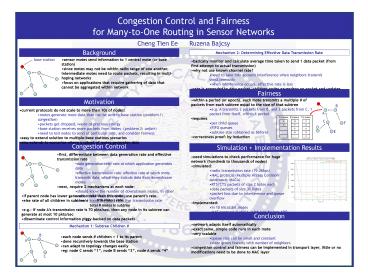Congestion Control and Fairness - PowerPoint PPT Presentation
1 / 1
Title:
Congestion Control and Fairness
Description:
MAC protocol (Multiple Access Collision Avoidance, MACA) RTS/CTS packets of size 2 bytes each ... MAC protocol is MACA, with hop-by-hop ARQ ... – PowerPoint PPT presentation
Number of Views:38
Avg rating:3.0/5.0
Title: Congestion Control and Fairness
1
Congestion Control and Fairness for Many-to-One
Routing in Sensor Networks
Cheng Tien Ee Ruzena Bajcsy
Background
Mechanism 2 Determining Effective Data
Transmission Rate
- sensor motes send information to 1 central mote
(or base station) - since motes may not be within radio range of one
another, intermediate motes need to route
packets, resulting in multi-hoping networks - focus on applications that require gathering of
data that cannot be aggregated within network
- basically monitor and calculate average time
taken to send 1 data packet (from first attempt
to actual transmission) - why not use known channel rate?
- need to take into account interference when
neighbors transmit simultaneously - when interference occurs, effective rate is less
- rate is appended to data packet, children nodes
eavesdrop on packet and updates
Fairness
- within a period (or epoch), each mote transmits a
multiple of packets from each subtree equal to
the size of that subtree - e.g. A transmits 2 packets from B, and 3 packets
from C, 1 packet from itself, within 1 period - requires
- per child queue
- FIFO queues
- subtree size (obtained as before)
- correctness proof by induction
Motivation
- current protocols do not scale to more than 10s
of nodes! - motes generate more data than can be sent to base
station (problem 1 congestion) - packets get dropped, waste of precious energy
- base station receives more packets from motes
(problem 2 unfair) - need to tell nodes to send at particular rate,
and consider fairness - easy to extend solution to multiple-base stations
scenarios - also extends to scenarios where a subset of motes
generates data
Bs queue
Cs queue
As queue
B
C
A
F
A
D
F
E
B
D
C
Congestion Control
Simulation Implementation Results
- first, differentiate between data generation rate
and effective transmission rate - data generation rate rate at which application
generates data - effective transmission rate effective rate at
which mote transmits data, which may include data
from downstream motes - next, require 2 mechanisms at each node
- should know the number of downstream motes, in
other words, children in its subtree - should know the local effective transmission rate
- need simulations to check performance for huge
network (hundreds to thousands of nodes) - simulated
- radio transmission rate (19.2kbps)
- MAC protocol (Multiple Access Collision
Avoidance, MACA) - RTS/CTS packets of size 2 bytes each
- data packets of size 30 bytes
- packet loss due to interference and queue
overflow - implemented
- in 10 Mica2dot motes
- MAC protocol is MACA, with hop-by-hop ARQ
- if parent node has lower generation rate than
this node, use parents rate, - else rate of all children in subtree
- e.g. if node As transmission rate is 70
pkts/sec, then any node in its subtree can
generate at most 10 pkts/sec - disseminate control information piggy-backed on
data packets
Conclusion
- network adapts itself automatically
- exact same, simple code runs in each mote
- very scalable
- queue size can be small and constant
- state grows linearly with number of neighbors
- congestion control and fairness can be
implemented in transport layer, little or no
modifications need to be done to MAC layer
Mechanism 1 Subtree Children
- each node sends children 1 to its parent
- done recursively towards the base station
- can adapt to topology changes easily
- eg node C sends 1, node B sends 3, node A
sends 4































